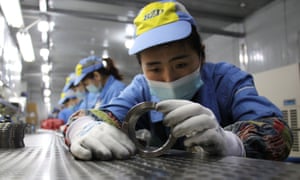Country was expanding at a faster rate than before the coronavirus pandemic at the end of 2020

Workers checking aluminium pistons for vehicle engines at a factory in Binzhou, Shandong province, China. Photograph: AFP/Getty Images
China’s economy has posted its strongest growth in two years after completing a rapid recovery from the slump caused by the Covid-19 pandemic at the start of 2020.
Although the 2.3% annual increase in activity for the world’s second biggest economy was its slowest since 1976, by the final three months of last year China was expanding at a faster rate than before the crisis.
Analysts said China’s success in being the one big economy to avoid a year-on-year fall in output was due to Beijing’s rapid response to the pandemic after cases were first detected in Wuhan, government stimulus and international demand for the country’s manufactured goods.
Paul Donovan, the chief economist at UBS Global Wealth Management, said: “China’s growth reflects global patterns. Domestic retail sales underperformed the economy – it is external demand that is supportive. As European and US consumers switch spending from services to goods, manufacturing economies outperform.”
Official figures showed the economy continued to pick up pace after contracting for the first time in four decades in the first three months of 2020. After growing at an annual rate of 4.9% in the third quarter, China’s expansion rose to 6.5% in the fourth quarter.
Julian Evans-Pritchard, the senior China economist at Capital Economics, said: “The monthly data suggest that growth dropped back slightly heading into 2021 but it remains strong. We think this strength will persist during the first half of this year, before giving way to a weaker second half.”
A breakdown of the GDP figures showed industrial production remained strong in December, growing at an annual rate of 7.3% but retail sales growth slipped back from 5% to 4.6%.
Evans-Pritchard said that despite the dip in retail sales growth, there was plenty of potential for households to start spending again as they run down the excess savings they built up last year.
He added: “Meanwhile, the tailwinds from last year’s stimulus should keep industry and construction strong for a while longer. Favourable base effects will also help keep growth rates elevated until at least the middle of this year.
“Further ahead, however, we think growth will soften. Foreign demand for Chinese goods will drop back as vaccines start to reverse the recent shift in global consumption patterns. And domestic policy support will be partially withdrawn throughout this year.”
News of the better-than-expected growth figures came as China reported more than 100 new Covid-19 cases for a sixth day, raising concerns of another national outbreak.
Most other big economies have yet to published GDP figures for 2020, but none are expected to record positive growth. Germany said last week it had contracted by 5%, while falls of about 10% have been pencilled in for the UK, France and Italy by the International Monetary Fund. The US, the world’s biggest economy is expected to contract by a little over 4%.
